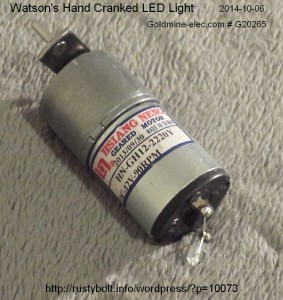I’ve thought about putting a series string of LED lamps into a Moebius Loop to make a free energy generator. No telling if the thing will work. 😉
The LEDs
I bought a box of 100 Sencart LEDS from dealextreme.com more than a month ago and they finally arrived this week. The cost was under $5 USD, with free shipping. These were commonly called strawhat because of the shape of the package. The LED chip is very close to the surface of the lens, so the light beam is unfocused and the light spreads out very evenly over nearly 180 degrees. The light is a warm white, 3000 to 3500 K, very close to an incandescent bulb. I tried one in a Joule Thief, and I’m happy with the results.
One thing that concerns me is the quality and cost. I’ve purchased inexpensive white LEDs before from sources in Asia and I’ve been disappointed with the results. Typically the white LEDs quickly lose brightness and go dim in less than 1500 hours. In one blog (now gone) I showed four ‘used’ LEDs and one new LED, all identical, shining on a wall. The single LED was much brighter than the four used LEDs. They were all in series, so the current was identical in all five. The old adage “caveat emptor” applies here.
The Hand Cranked Flashlight
 So now that I have a hundred of these LEDs, what do I do with them? Well, here’s one use for these LEDs. I bought several of these motors with gears and a crank on the end from goldmine-elec.com for $8.95 apiece, or about ten dollars with shipping. The crank allows one to turn the shaft by hand and the gears speed up the motor revolutions so that the LED soldered directly across the two terminals puts out a decent amount of light while cranking about 40 turns per minute. It’s easy to do, but the crank is small diameter and my fingers got sore after a few minutes of cranking. This can be fixed by putting some heat shrink tubing over the crank shaft, or soldering 6 or so washers to the crank shaft to make it larger diameter. I measured the shaft at 0.125 inch or 3.1 mm diameter.
So now that I have a hundred of these LEDs, what do I do with them? Well, here’s one use for these LEDs. I bought several of these motors with gears and a crank on the end from goldmine-elec.com for $8.95 apiece, or about ten dollars with shipping. The crank allows one to turn the shaft by hand and the gears speed up the motor revolutions so that the LED soldered directly across the two terminals puts out a decent amount of light while cranking about 40 turns per minute. It’s easy to do, but the crank is small diameter and my fingers got sore after a few minutes of cranking. This can be fixed by putting some heat shrink tubing over the crank shaft, or soldering 6 or so washers to the crank shaft to make it larger diameter. I measured the shaft at 0.125 inch or 3.1 mm diameter.
Of course the motor and crank can still be used for its original purpose, as a motor. The crank can be attached to something that moves, and a power source such as a solar panel can be used to run it. The ad says it will run at 3 volts, so a low voltage source such as a battery could be used. I would put a microphone on an amplifier to make the crank move something when there’s a loud sound. Or the crank could be used to point the solar panel to pick up the most sunlight. I wonder what their original use was? Perhaps in a VHS tape player to pull the cassette in and out? I hope they go on sale; for a hand cranked flashlight, ten dollars is a bit expensive.
I added a second warm white LED to the first one; it puts out more light as I expected, but it’s harder to crank. I’m going to try one with the head of a 9 LED flashlight, to see if it does as good a job as three AAA cells. It might be too much to crank.
Instead, I used the head of a 3 LED flashlight. It puts out a decent amount of light, but it’s a sickly blue-white, like there is not enough phosphor to cover the LED chip, with the blue light leaking through.
I also connected two warm white LEDs in series. It’s easier to crank but probably puts out less light than 2 in parallel.
Update Nov 10 – I have a cheap “desk light” – actually more of a toy due to the battery compartment in the base; it does have an AC adapter, though. The 12 LEDs in it were dim and “used up” and put out a small fraction of the light when it was new. I unscrewed the head and replaced the old ones with the warm white LEDs. Now it’s much, much brighter and makes a decent reading light.
I ordered more of the motors, but they emailed that the motors had all been sold so that they could only partially fill my order. I guess the early birds got all the worms. 😉
I also got some switch assortments. The types of switches may vary with each assortment pack. These were all C & K switches, very high quality. Most were in good condition, with a few missing a part, but still usable. There were several SPDT pushbutton switches, which are especially good for certain timer circuits. Some were for mounting on a circuit board.